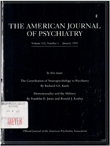Psychopathology and psychiatric diagnoses of World War II Pacific theater prisoner of war survivors and combat veterans
Abstract
OBJECTIVE: This study assessed current and long-term psychological and psychiatric sequelae of war trauma in World War II Pacific theater combat veterans, some of whom had been Japanese prisoners of war (POWs). METHOD: A group of 36 POW survivors and a group of 29 combat veterans, all of whom had seen fierce fighting and heavy unit casualties, were compared approximately 40 years later on psychological instruments assessing psychopathology constructs, negative mood states, and symptoms of posttraumatic stress disorder (PTSD) and on the computer-administered National Institute of Mental Health Diagnostic Interview Schedule. RESULTS: Although similar in personal backgrounds and in having suffered catastrophic war trauma, the two groups differed in the severity and type of psychiatric symptoms and in the occurrence of psychiatric disorders. Anxiety and depressive disorders were common in both groups, but there were differences in the frequency of PTSD diagnoses. Among the POW survivors, 70% fulfilled the criteria for a current diagnosis and 78% for a lifetime diagnosis of PTSD, compared to 18% and 29%, respectively, of the combat veterans. CONCLUSIONS: The findings point to the persistent nature of symptoms thought to be residuals of extraordinary stress and the relation between severity of psychiatric sequelae and characteristics of the stressors.
Access content
To read the fulltext, please use one of the options below to sign in or purchase access.- Personal login
- Institutional Login
- Sign in via OpenAthens
- Register for access
-
Please login/register if you wish to pair your device and check access availability.
Not a subscriber?
PsychiatryOnline subscription options offer access to the DSM-5 library, books, journals, CME, and patient resources. This all-in-one virtual library provides psychiatrists and mental health professionals with key resources for diagnosis, treatment, research, and professional development.
Need more help? PsychiatryOnline Customer Service may be reached by emailing [email protected] or by calling 800-368-5777 (in the U.S.) or 703-907-7322 (outside the U.S.).



